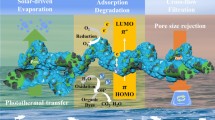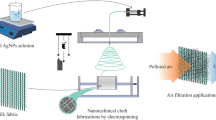Abstract
A Pickering emulsion liquid membrane (PELM) stabilized by oleic acid-coated Fe3O4 nanoparticles has been prepared and used to extract phenolic compound from wastewater. Compared to traditional emulsion liquid membrane (ELM), nano-Fe3O4 particle-stabilized PELM can be easily demulsified after extraction under magnetic field, which could greatly improve the reutilization of oil phase and reduce the energy consumption of ELM operation. Practically, our PELM contains tri-n-butyl phosphate as a carrier, corn oil as a liquid membrane, and sodium hydroxide as a stripping agent. The stability of Pickering emulsion was investigated under different homogenization speeds and characterized by centrifugal stability method. Reutilization of emulsifier and oil phase exhibited comparable extraction efficiency after three cycles of remediation, and no significant change on the particle property was observed.






Similar content being viewed by others
References
Ramsden W (1903) Separation of solids in the surface-layers of solution and ‘suspensions’-preliminary account. Proc R Soc Lond 72:156–164
Pickering SU (1907) Emulsions. J Chem Soc 1:2001–2021
Chevalier Y, Bolzinger M (1907) Emulsions stabilized with solid nanoparticles: Pickering emulsions. Colloids Surf A 439:23–34
Lee GJ, Son HA, Cho JW, Choi SK, Kim HT, Kim JW (2014) Stabilization of Pickering emulsions by generating complex colloidal layers at liquid–liquid interfaces. J Colloid Interface Sci 413:100–105
Liu J, Yin D, Zhang S, Liu H, Zhang Q (2015) Synthesis of polymeric core/shell microspheres with spherical virus-like surface morphology by Pickering emulsion. Colloids Surf A 466:174–180
Binks BP (2002) Particles as surfactants—similarities and differences. Curr Opin Colloid Interface Sci 7:21–41
Tang J, Lee MFX, Zhang W, Zhao B, Berry RM, Tam KC (2014) Dual responsive Pickering emulsion stabilized by poly[2-(dimethylamino)ethyl methacrylate] grafted cellulose nanocrystals. Biomacromolecules 78:29–59
Li Z, Ngai T (2011) Stimuli-responsive gel emulsions stabilized by microgel particles. Colloid Polym Sci 289:489–496
Chen Z, Zhou L, Bing W, Zhang Z, Li Z, Ren J, Qu X (2014) Light controlled reversible inversion of nanophosphor-stabilized Pickering emulsions for biphasic enantioselective biocatalysis. J Am Chem Soc 20:7498–7504
Tsuji S, Kawaguchi H (2008) Thermosensitive Pickering emulsion stabilized by poly(N-isopropylacrylamide)-carrying particles. Langmuir 24:3300–3305
Liang J, Li H, Yan J, Hou W (2014) Demulsification of oleic-acid-coated magnetite nanoparticles for cyclohexane-in-water nanoemulsions. Energy Fuel 28:6172–6178
Liang J, Du N, Song S, Hou W (2015) Magnetic demulsification of diluted crude oil-in-water nanoemulsions using oleic acid-coated magnetite nanoparticles. Colloids Surf A 466:197–202
Li NN (1974) Separating hydrocarbons with liquid membranes. US Patent USRE27888E
Park H-J, Chung TS (2003) Removal of phenol from aqueous solution by liquid emulsion membrane. Korean J Chem Eng 20:731–735
Lin SH, Pan CL, Leu HG (1999) Liquid membrane extraction of 2-chlorophenol from aqueous solution. J Hazard Mater 65:289–304
Chaouchi SHO (2014) Extraction of priority pollutant 4-nitrophenol from water by emulsion liquid membrane: emulsion stability, effect of operational conditions and membrane reuse. J Dispers Sci Technol 35:1278–1288
Park Y, Skelland AHP, Forney LJ, Kim J (2006) Removal of phenol and substituted phenols by newly developed emulsion liquid membrane process. Water Res 40:1763–1772
Mortaheb HR, Amini MH, Sadeghian F, Mokhtarani B, Daneshyar H (2008) Study on a new surfactant for removal of phenol from wastewater by emulsion liquid membrane. J Hazard Mater 160:582–588
Pezhman Kazemi MPAB (2014) Stability and extraction study of phenolic wastewater treatment by supported liquid membrane using tributyl phosphate and sesame oil as liquid membrane. Chem Res Des 92:375–383
Sznejer G (1999) Cadmium removal from aqueous solutions by an emulsion liquid membrane: the effect of resistance to mass transfer at the outer oil–water interface. Colloids Surf A 151:77–83
Fouad E, Ahmad F, Elsherbiny M (2014) Emulsion liquid membrane extraction of cadmium using tri octyl phosphine oxide as a carrier: analytical process optimization by using Taguchi design method. Int J Chem Environ Eng 5:51–56
Yipeng Wei PLWW (2015) Well-controlled and stable emulsion ATRP of MMA with low surfactant concentration using surfactant-ligand design as copper capture agent. Poly Chem 6:2837–2843
Eyupoglu V, Kumbasar RA (2015) Extraction of Ni(II) from spent Cr–Ni electroplating bath solutions using LIX 63 and 2BDA as carriers by emulsion liquid membrane technique. J Ind Eng Chem 21:303–310
Gurel L, Altas L, Buyukgungor H (2005) Removal of lead from wastewater using emulsion liquid membrane technique. Environ Eng Sci 22:411–420
Ehtash M, Fournier-Salaün M, Dimitrov K, Salaün P, Saboni A (2014) Phenol removal from aqueous media by pertraction using vegetable oil as a liquid membrane. J Chem Eng 250:42–47
Luan J, Plaisier A (2004) Study on treatment of wastewater containing nitrophenol compounds by liquid membrane process. J Memb Sci 229:235–239
Yan CN, Othman N, Yi OZ (2014) Prediction of kraft lignin extraction performance using emulsion liquid membrane carrier-diffusion model. Teknol J 67:17–21
Lin Zhaoyun, Zhang Zhe, Li Youming, Deng Yulin (2016) Magnetic nano-Fe3O4 stabilized Pickering emulsion liquid membrane for selective extraction and separation. Chem Eng J 288:305–311
Lan Q, Liu C, Yang F, Liu S, Xu J, Sun D (2007) Synthesis of bilayer oleic acid-coated Fe3O4 nanoparticles and their application in pH-responsive Pickering emulsions. J Colloid Interface Sci 310:260–269
Yinhua Wan XWXZ (1997) Treatment of high concentration phenolic waste water by liquid membrane with N5o3 as mobile cartier. J. Memb Sci 135:263–270
Acknowledgements
Z. Lin thanks the fellowship supported by the China Scholarship Council (CSC), and Zhe Zhang thanks the PSE fellowship provided by Renewable Bioproducts Institute at Georgia Tech.
Author information
Authors and Affiliations
Corresponding author
Rights and permissions
About this article
Cite this article
Lin, Z., Zhang, Z., Li, Y. et al. Recyclable magnetic-Pickering emulsion liquid membrane for extracting phenol compounds from wastewater. J Mater Sci 51, 6370–6378 (2016). https://doi.org/10.1007/s10853-016-9933-4
Received:
Accepted:
Published:
Issue Date:
DOI: https://doi.org/10.1007/s10853-016-9933-4




